
The Howrah Bridge is a balanced cantilever bridge over the Hooghly River in West Bengal. Commissioned in 1943, the bridge was originally named the New Howrah Bridge, because it replaced a pontoon bridge at the same location linking the cities of Howrah and Kolkata (Calcutta). On 14 June 1965, it was renamed Rabindra Setu after the great Bengali poet Rabindranath Tagore, who was the first Indian and Asian Nobel laureate. It is still popularly known as the Howrah Bridge.

Vivekananda Setu is a bridge over the Hooghly River in West Bengal, India. It links the city of Howrah, at Bally, to Kolkata, at Dakshineswar. Completed on 1931, it is a multispan truss bridge and was built to primarily to provide direct road and rail connectivity between the Calcutta Port and the major railhead at Howrah railway station on the West bank of the Hooghly River. It is 2,887 feet (880 m) long having 9 spans in total. The famous Dakshineswar Kali Temple is situated on the banks of the Hooghly River near the bridge. The bridge is one of the four bridges linking Howrah and Kolkata. A new road bridge, the Nivedita Setu, was constructed 50 m (160 ft) downstream in 2007 due to weakening of the Vivekanada Setu caused by its ageing.
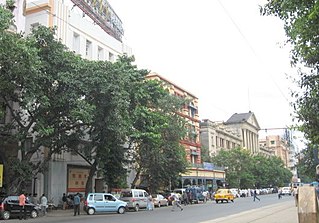
Esplanade is a neighbourhood of Central Kolkata, in Kolkata district in the Indian state of West Bengal. This is not a conventional esplanade in the sense that the place is not exactly situated alongside a waterbody. However, the Ganga river (Ganges), also known as Hooghly river, flows nearby.
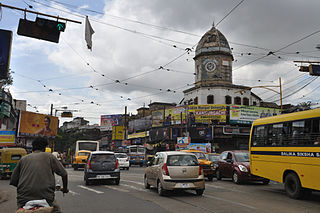
Maniktala is a residential area of North Kolkata, in Kolkata district, West Bengal, India.
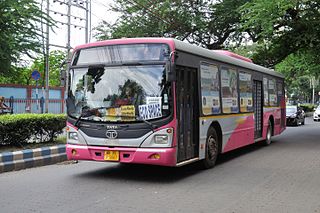
The transport system of Kolkata, a city in India, is a mix of modern mass rapid transport and old transport modalities like rickshaws. Kolkata is connected to the rest of India by the National Highways, the extensive network of the Indian Railways, National Waterways and by air. The most traffic to Northeast India route via Kolkata.

Calcutta Tramways Company (CTC) was a state-run company that operated trams and buses in and around Kolkata in West Bengal, India. The Kolkata tram is the only operating tramway in India and is the oldest electric tram in India, operating since 1902.
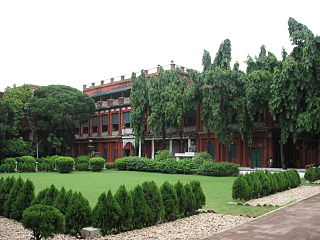
Jorasanko is a neighbourhood of North Kolkata, in Kolkata district, West Bengal, India. It is so called because of the two (jora) wooden or bamboo bridges (sanko) that spanned a small stream at this point.

Chitpur is a neighbourhood in North Kolkata in Kolkata district in the Indian state of West Bengal. Sometimes, the entire area along Chitpur Road is referred to as Chitpur, although the various localities have distinctive names.
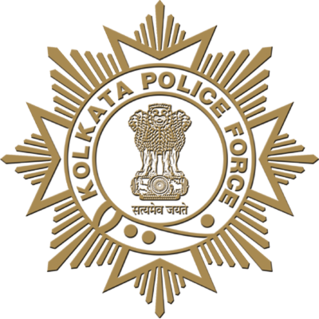
Kolkata Traffic Police has the job of managing the flow of traffic in the city of Kolkata, India. It is the traffic police unit within the Kolkata Police.

Bagbazar is a neighbourhood of North Kolkata, in Kolkata district in the Indian state of West Bengal. The area, under Shyampukur police station of Kolkata Police, has been, along with neighbouring Shyambazar, the citadel of the Bengali aristocracy. Bagbazar has played an active role in growth and development of Kolkata.

Rajabazar is a locality in the city of Kolkata in West Bengal, India. It is located in between CIT Road and APC Road. The locality has grown around Narkeldanaga Main Road, which acts as a connector between CIT Road and APC Road. Thus, Rajabazar can be said to be located between Maniktala, Narkeldanga and Sealdah.

Acharya Jagadish Chandra Bose Road and its continuation northwards called Acharya Prafulla Chandra Road, are together the longest and the most important north-south thoroughfare in Kolkata, India.

Bepin Behari Ganguly Street, or B.B. Ganguly Street, formerly known as Bow Bazar Street or Bowbazar Street, is an east-west road in Central Kolkata, capital of the Indian state of West Bengal. It passes through Bowbazar area and connects Baithakkhana Market (Sealdah) and Sealdah Station with Bentinck Street/Rabindra Sarani crossing (Lalbazar) via Amherst Street crossing, Nirmal Chandra Street/College Street crossing and Central Avenue crossing. West of Bentinck Street crossing, B.B. Ganguly Street becomes Lalbazar Street. This road's name is a tribute for Bepin Behari Ganguly, a famous freedom-fighter and politician of India.

Vidyasagar Setu, also known as the Second Hooghly Bridge, is a toll bridge over the Hooghly River in West Bengal, India, linking the cities of Kolkata and Howrah.

Sealdah is a neighbourhood of Central Kolkata in Kolkata district in the Indian state of West Bengal.

The tram system in the city of Kolkata, West Bengal, India, operated by West Bengal Transport Corporation (WBTC) after Calcutta Tramways Company (CTC) was dissolved, is the oldest existing tram network operating in India, and oldest operating tramway in Asia. Started in 1902, it is the second oldest electric tramway in India.

Topsia is a neighbourhood of East Kolkata, in West Bengal, India.

























